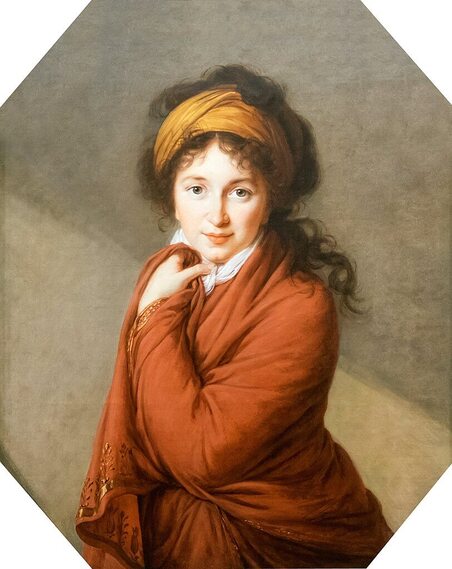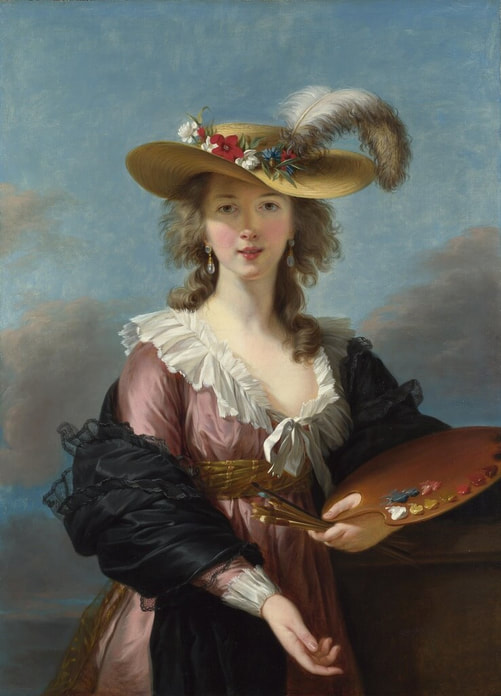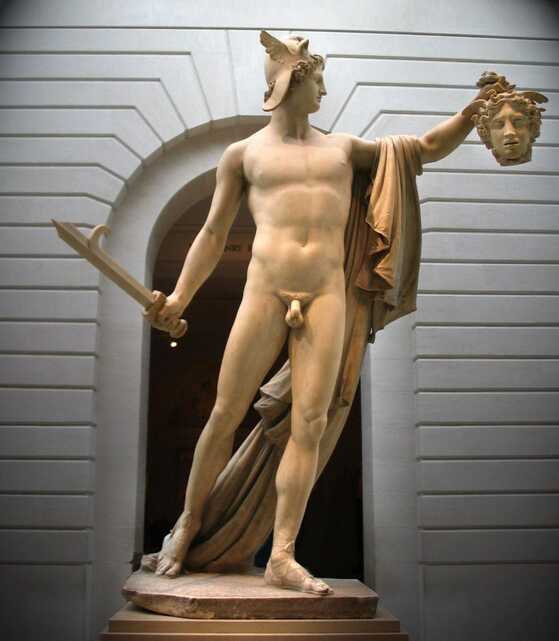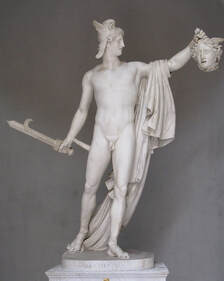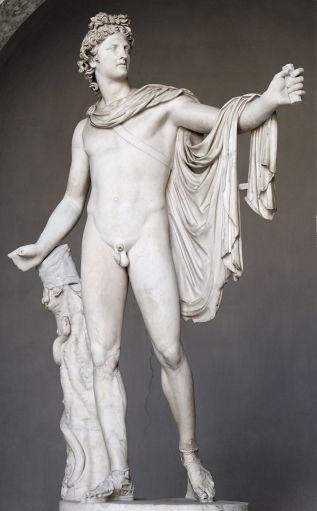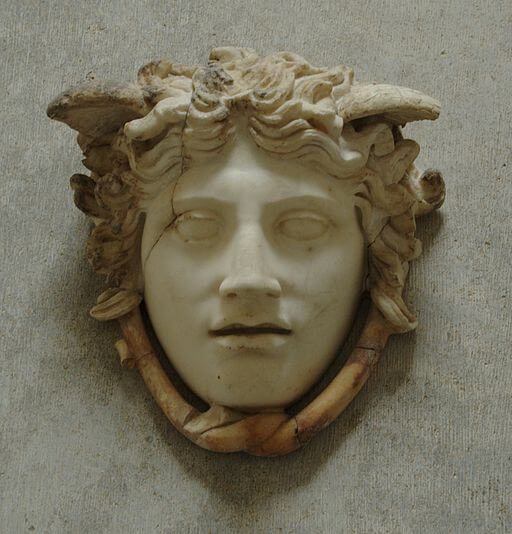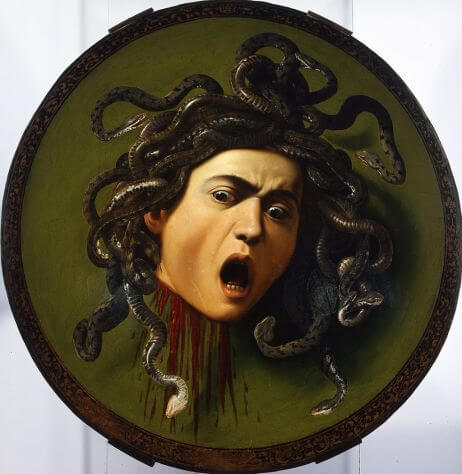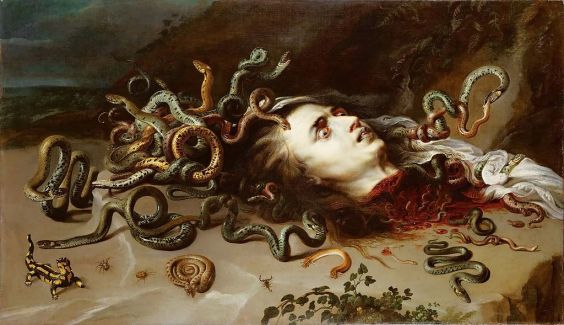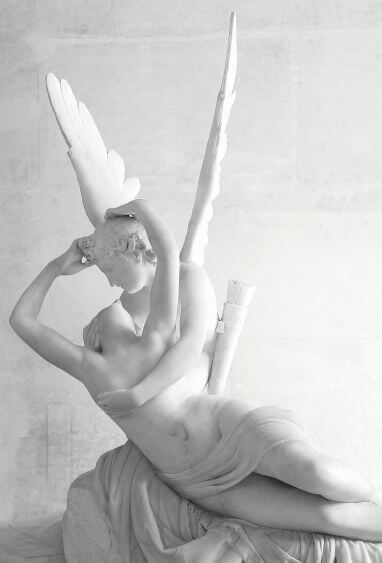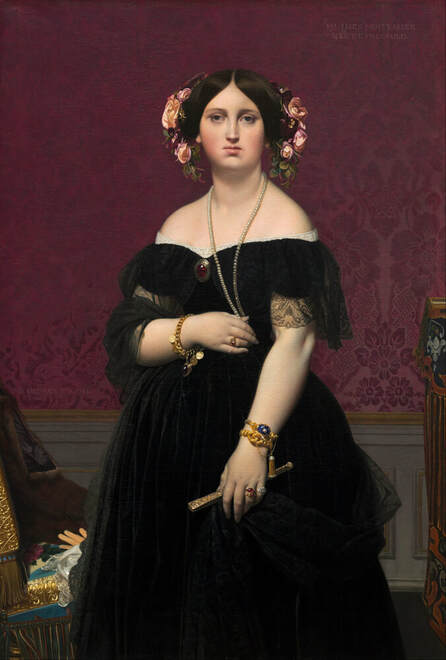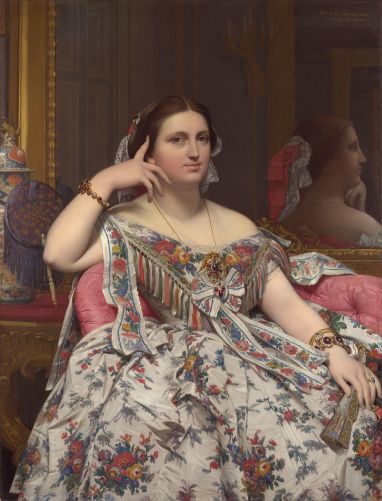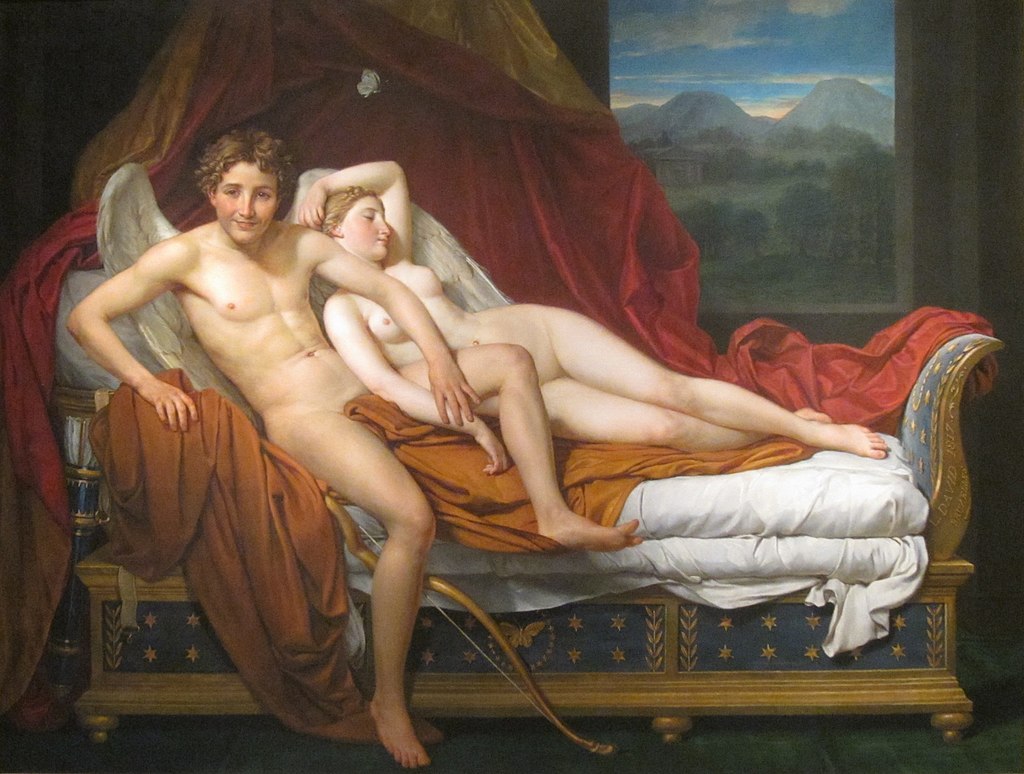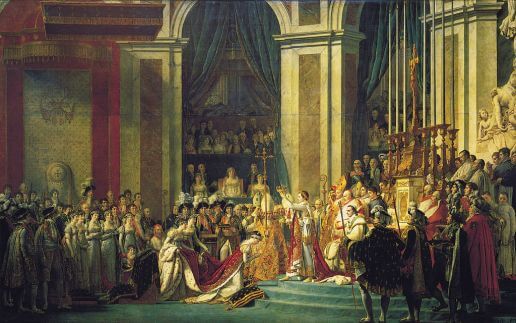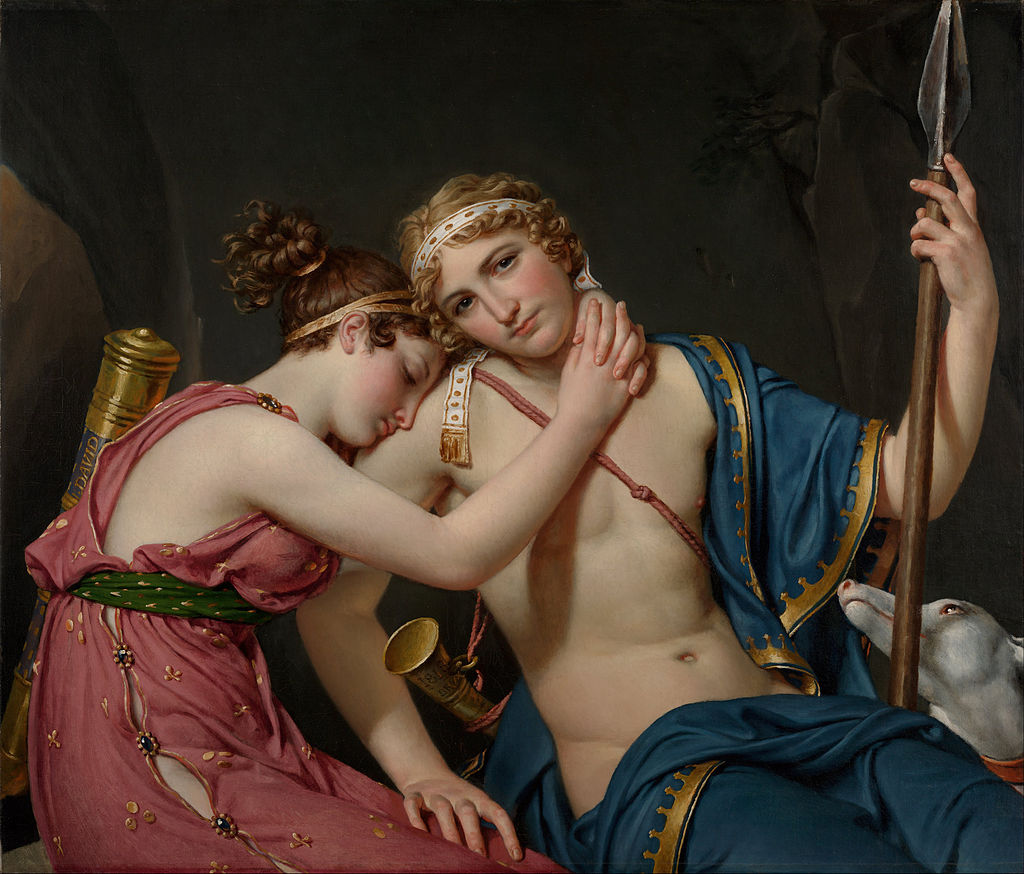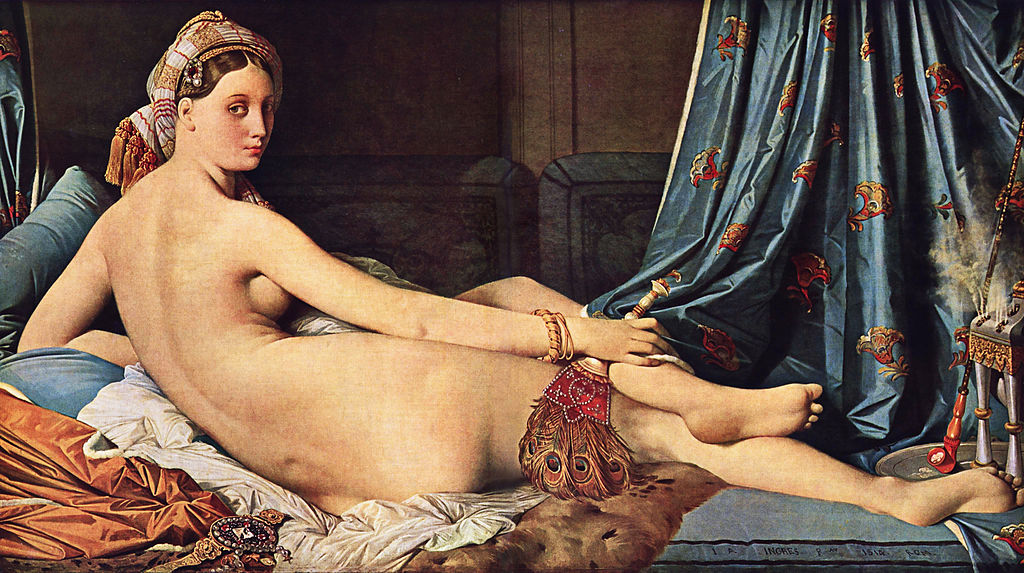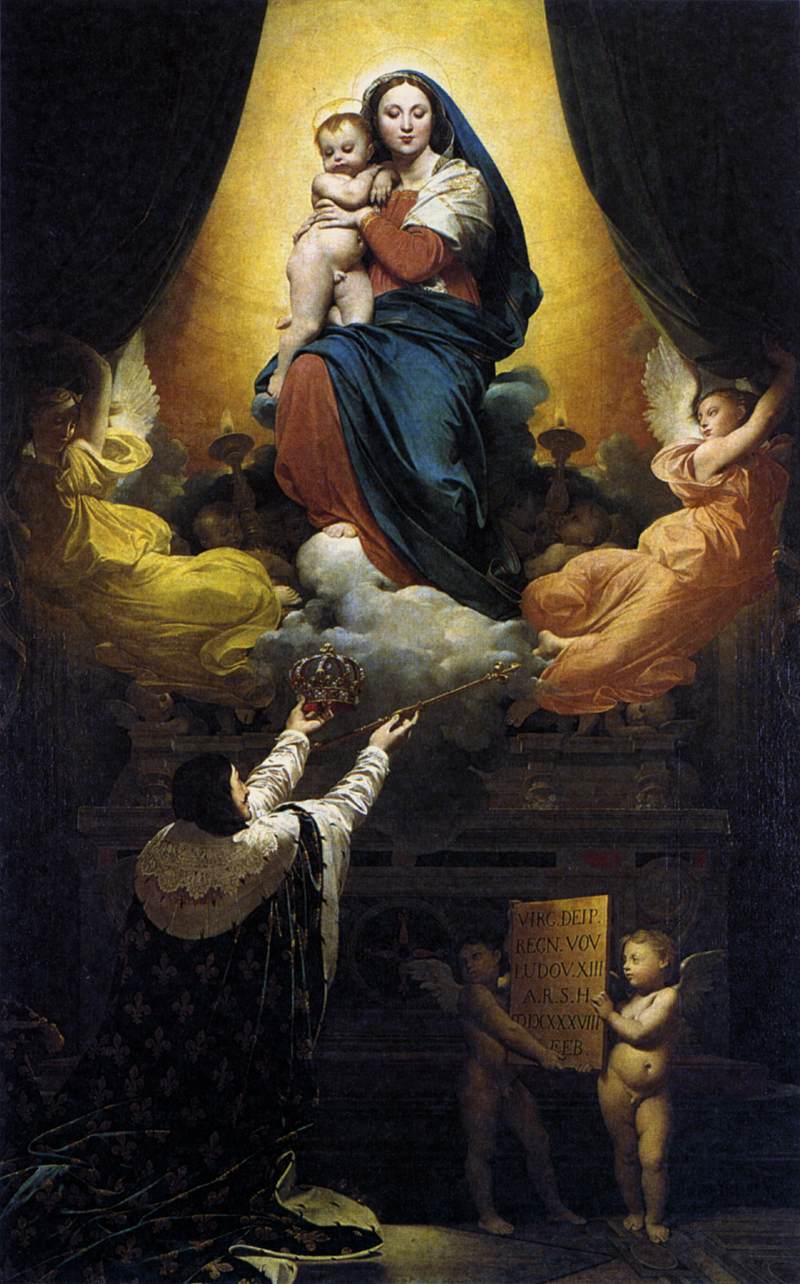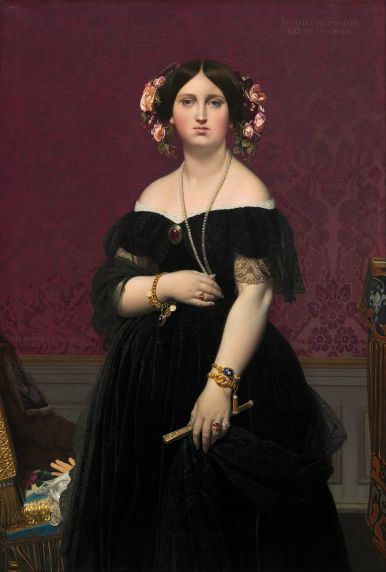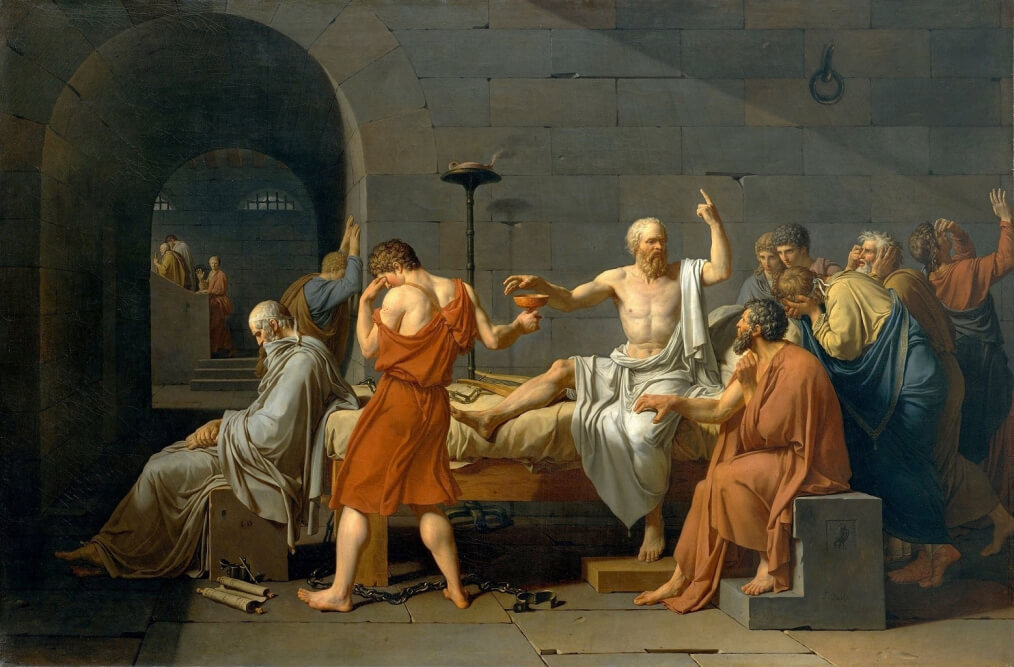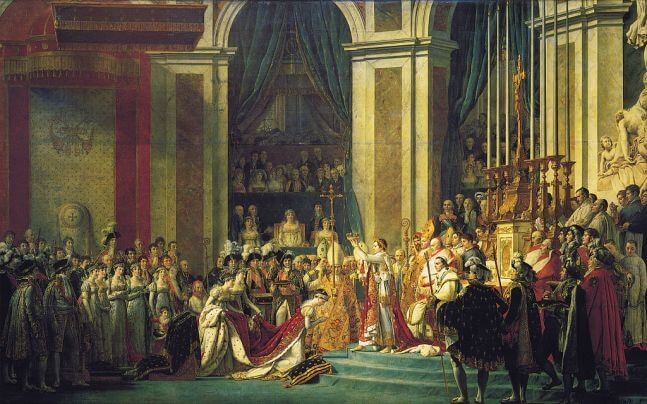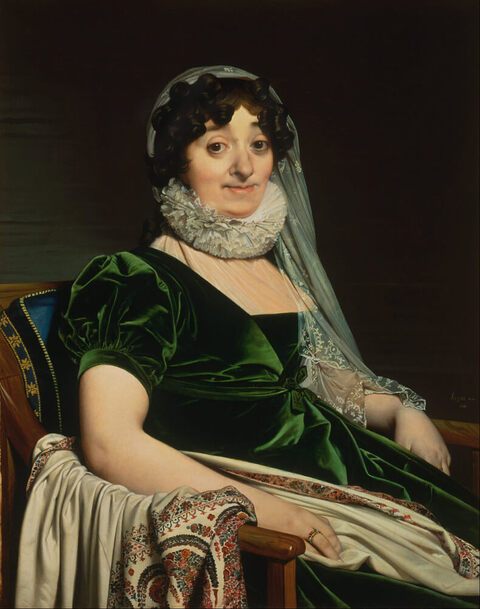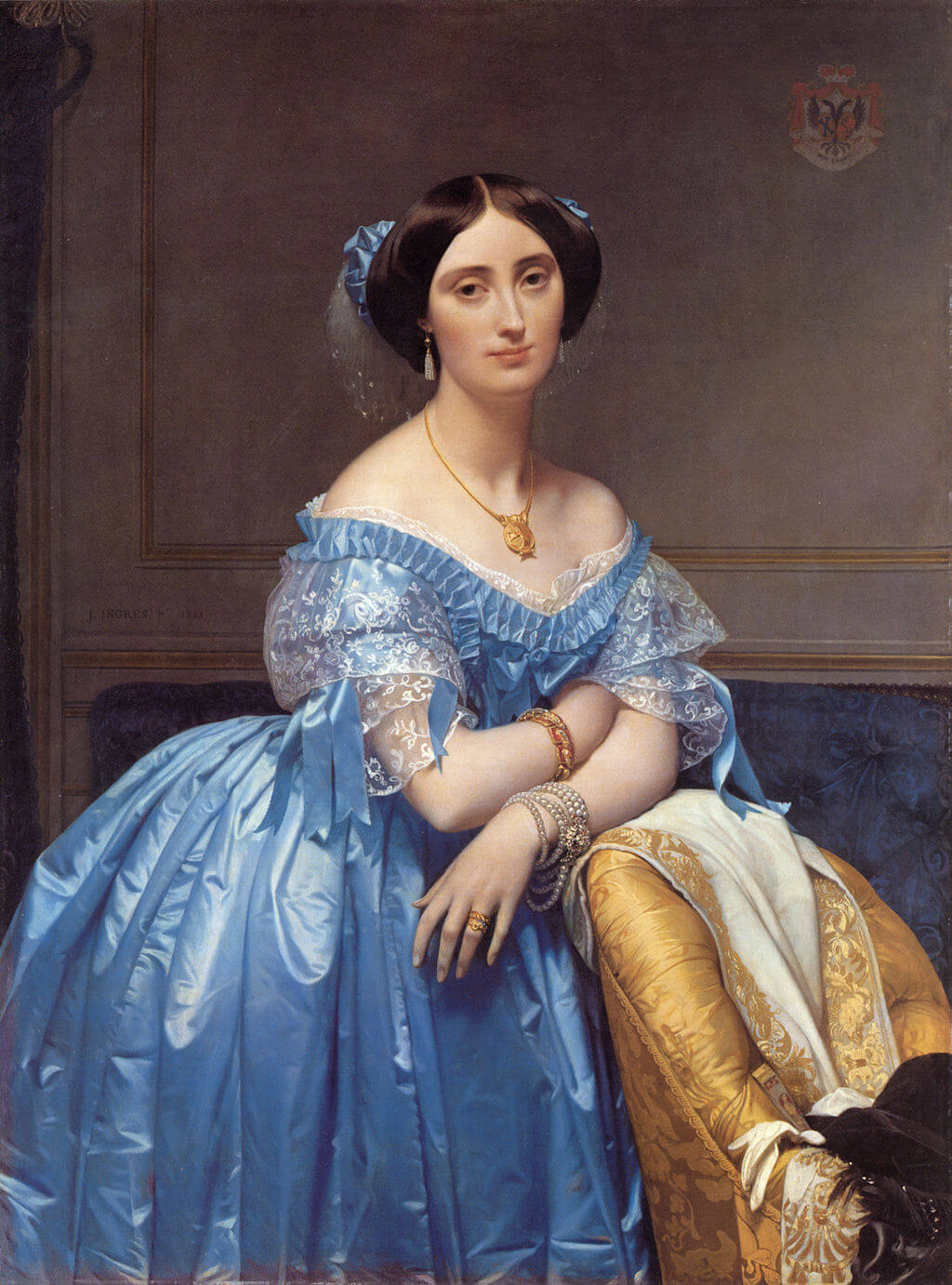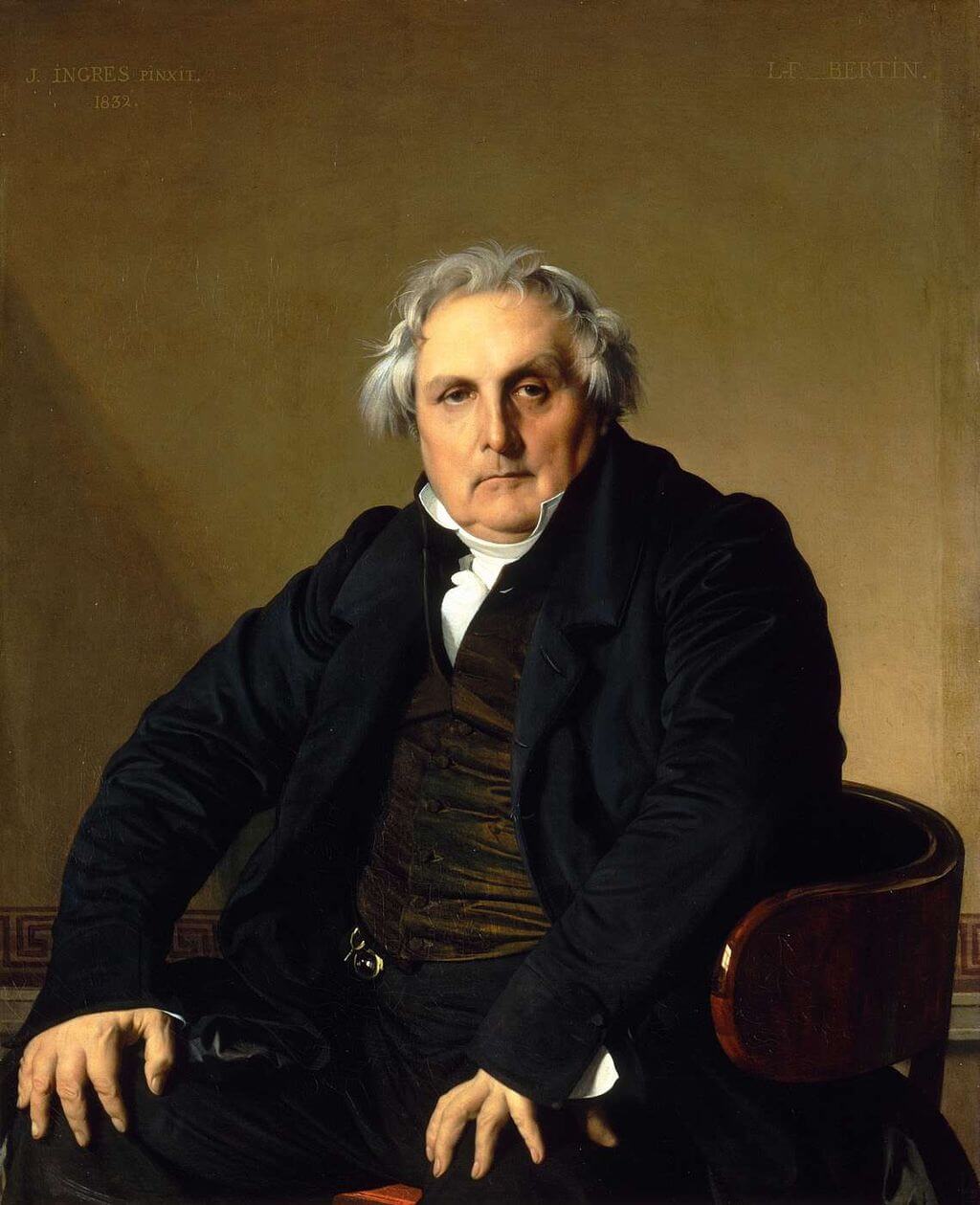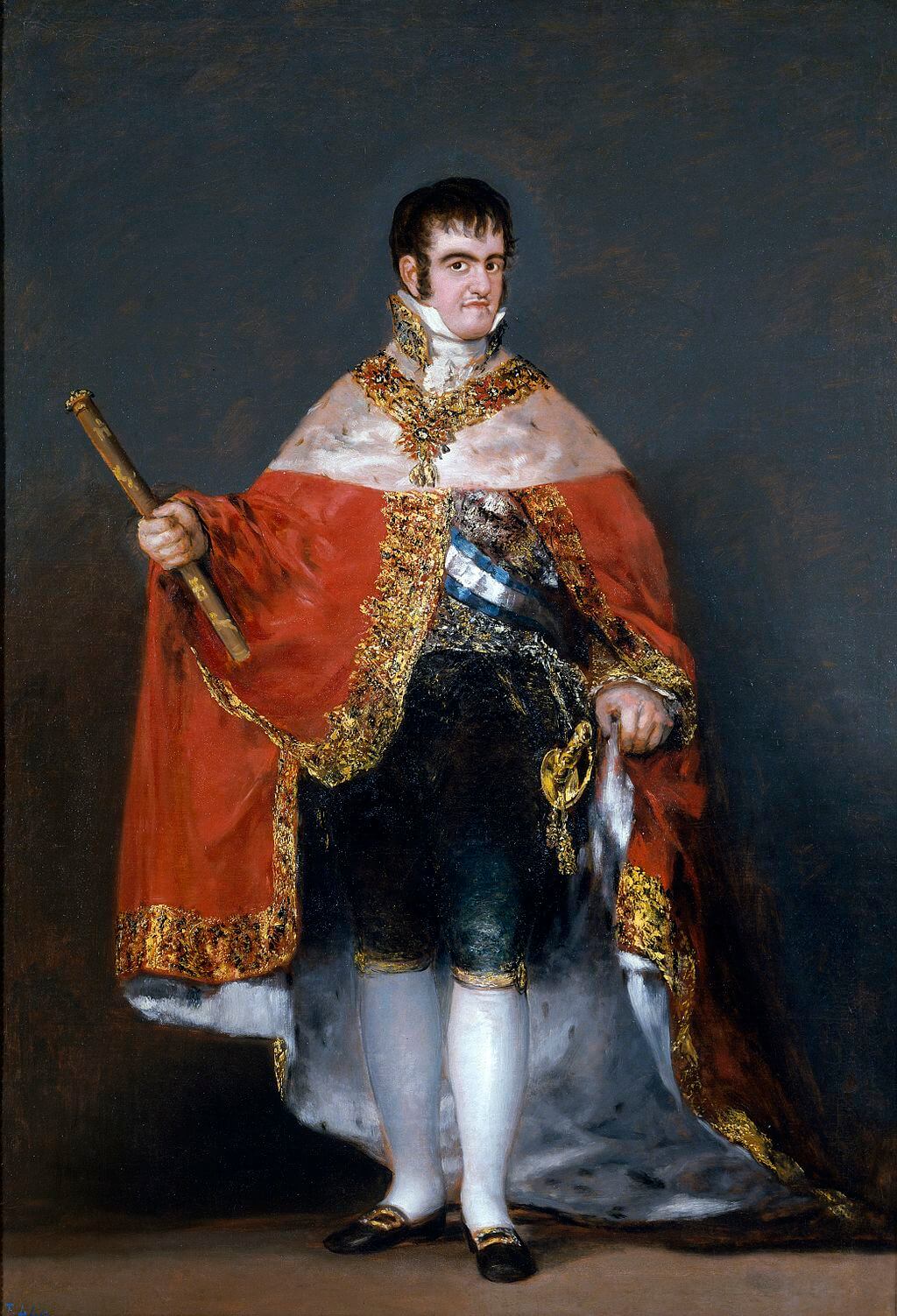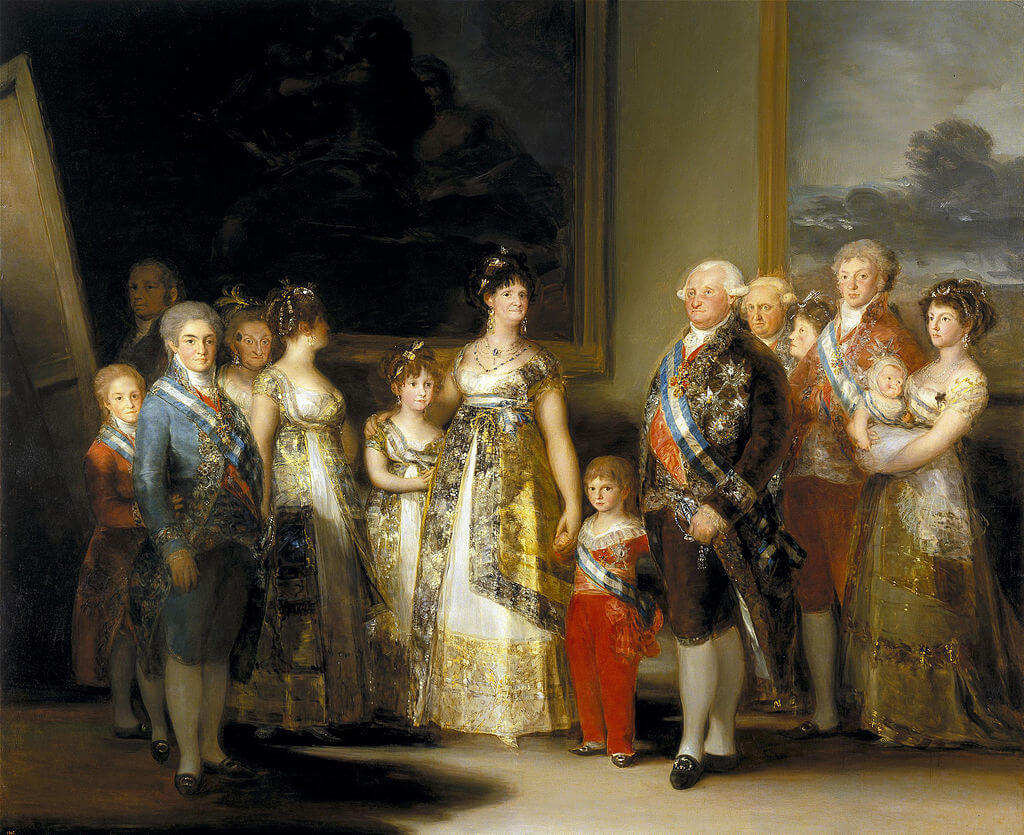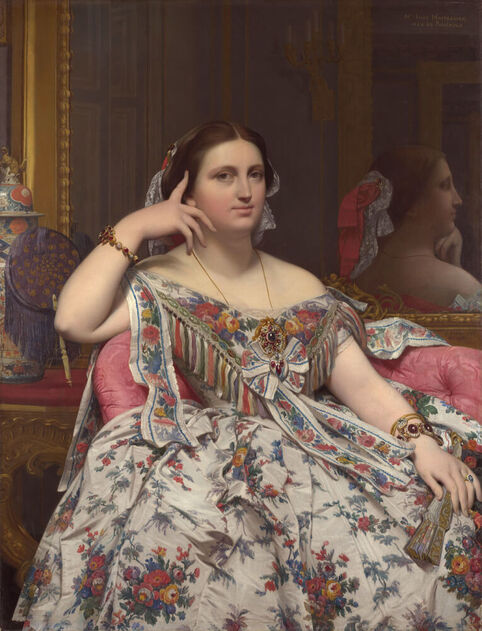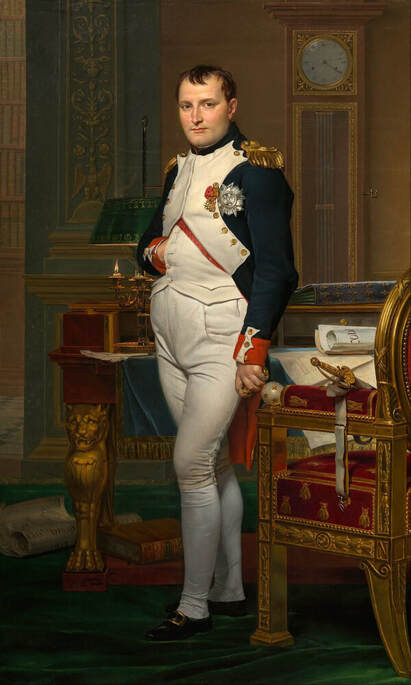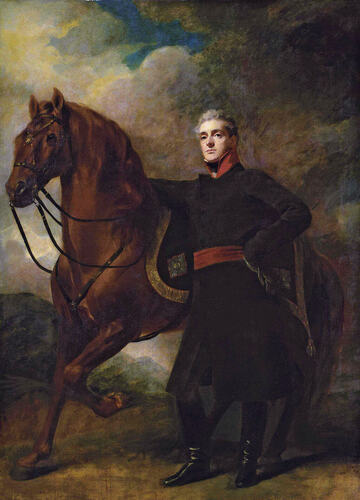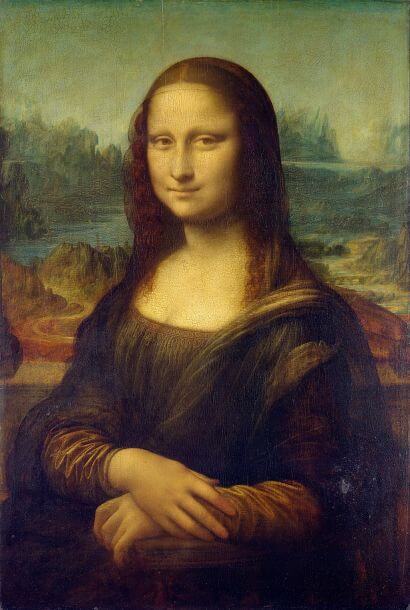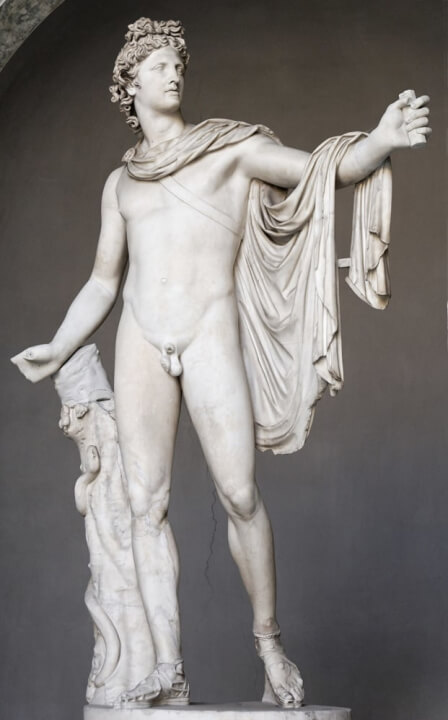|
Where? The Barber Institute of Fine Arts in Birmingham, England.
When? About 1800 Commissioned by? Most likely painted for the Golovine family. The painting remained in their possession until approximately 1978, when it was acquired by Gooden and Fox, then it was sold to the Barber Institute of Fine Arts in 1980. What? Oil on canvas, octagonal, 32 7/8 by 26 1/4 inches (83.5 by 66.7 cm.) What do you see? No matter what room this portrait of Countess Barbara Nicolaievna Golovine is in, it will be the first painting to demand attention. The innovative composition is a half-length figure in an octagonal shape and is further enhanced by an attractive gold frame. Vigée Le Brun has wrapped her subject entirely in a large, thick, rich, red stole with gold embroidered trim. The luxurious wrap is draped carefully but casually, and held gracefully at her neck by one hand, as if she has just come from her boudoir or the bath. The red shawl commands immediate attention. Her loose and free, brown, curling hair tumbles around her face and shoulder, held in place by a deep golden headband that has a twist and texture that adds to the framing of her face. There is a dimple in her chin that augments the slight smile on her face and blends gracefully with the shadows of the light and dark. In fact, the dimple makes her face much more interesting. The neutral, scumbled background has a diagonal shaft of light cutting across the canvas that adds clarity to her hand and facial features. It is an unusual backdrop that suits the countess’s dynamic pose. She faces us, while her body turns slightly to the left, suggesting motion. There is an erotic hint to the painting but that is over-whelmed by the soft smile and the warmth of her eyes as she engages the viewer. She is pleased to see her visitor, a friend, a well-liked friend, who will be welcomed and entertained with excellent conversation, perhaps a glass of French wine, for she was a member of the Russian Aristocracy, a Princess first, then a Countess, when friendships, manners and virtue mattered more than anything. As the viewer turns away, moving either to the left or right, a glance over a shoulder confirms that her eyes are following as she bids her farewell……it is not a portrait easily forgotten by anyone who views it, and one that many, return to view again and again.
0 Comments
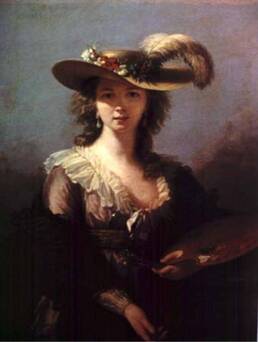 Original version of Self Portrait in a Straw Hat (1782) Original version of Self Portrait in a Straw Hat (1782)
Where? Room 33 of the National Gallery in London
When? 1782 Medium and size: Oil on canvas, 97.8 × 70.5 cm. What do you see? A self-portrait of the 27-year old Élisabeth Vigée Le Brun. She painted herself standing outside, wearing a straw hat with an ostrich feather and a garland of wildflowers. And she holds a palette and seven brushes in her left hand. She portrayed herself as an independent and emancipated woman, traits that helped her to become a successful artist in a male-dominated art world. Many other young ladies would have worn a corset, a wig, and a lot of make-up. Instead, Vigée Le Brun portrays herself in a fashionable, pink cotton dress, a black shawl, a straw hat, a pair of earrings, and her own hair. Vigée Le Brun paid particularly careful attention to the impact of two light sources, the sunlight and the daylight. The impact of the sunlight is apparent when looking at how she painted her eyes in the shadow of the straw hat. The result is that the viewer is naturally directed to look at her neck and chest. Backstory: The painting in the National Gallery is actually a copy of a version she made earlier in 1782 and exhibited at the Paris Salon. The original painting is in a Swiss private collection and only a low-resolution image of it is available. The self-portrait of Élisabeth Vigée Le Brun was inspired by the Portrait of Susanna Lunden (c. 1622-1625) by Peter Paul Rubens, which is also part of the collection of the National Gallery. In 1782, during her travels with her husband, she came across Rubens’ portrait in Antwerp. She was particularly impressed by the way Rubens simultaneously incorporated the effects of both natural daylight and sunlight. She immediately started to apply these ideas to her own portrait. After she returned to Paris, she created a second version of this painting, which is the one in the National Gallery today. The same year she also painted the Portrait of Yolande-Martine-Gabrielle de Polastron, Duchess of Polignac, which has a quite similar composition.
What do you see? This marble statue shows the Greek demigod Perseus holding the head of Medusa. Perseus is standing in a triumphant pose as he has just beheaded Medusa. He holds the head of Medusa in his left hand by grabbing the venomous snakes on her head. The face of Medusa expresses horror as it has just been cut off. However, you can also still see the beauty of her face.
Interestingly, Perseus is looking at her face, even though that should turn him into stone according to the myth (but the irony may be that this actually happened in this statue). Perseus is wearing the sandals of the Roman messenger god Mercury (Hermes in Greek) which allowed Perseus to fly. These sandals were made of gold by the god Vulcan (Hephaestus in Greek). Perseus also wears the cap of Hades, which could make him invisible. In his right hand, Perseus is holding a harpe sword, which is a sword with a sickle-like extension on one side of the blade. The sword was owned by Zeus, the father of Perseus. A robe hangs loosely over his arm. Notice that his left foot is standing in the front, while the heel of his right foot is lifted. In this way, Canova creates the sense that Perseus is moving forward.
Backstory: Antonio Canova made this statue twice. The first version is on display in the Vatican Museums and is also known as Perseus Triumphant. A replica by Canova is in the Metropolitan Museum of Art. The head of Medusa in this statue has been inspired by the Medusa Rondanini, a marble sculpture that is in the Glyptothek in Munich.
The rest of the statue has been heavily inspired by the Apollo Belvedere, a famous statue from antiquity, which is also in the Octagonal Court of the Vatican Museums. The first version of the statue of Perseus and Medusa was acquired by Pope Pius VII to replace the Apollo Belvedere which Napoleon Bonaparte had confiscated and shipped to the Louvre in Paris. When the Apollo Belvedere returned to Rome, they kept the statue of Canova as it was such a great piece of work. When the second version of this statue first arrived at the Metropolitan Museum of Art, the sword was missing. They took a cast from the version in the Vatican Museums and added a newly carved marble sword to the statue.
The story of Perseus and Medusa: In Greek mythology, Perseus is the son of Jupiter (Zeus in Greek), who was the king of the gods, and Danaë. Polydectes, the King of Seriphos, ordered Perseus to provide him with the head of Medusa as a wedding gift for him.
Medusa was one of three sisters (Stheno, Euryale, and Medusa) who were often referred to as Gorgons. Both Stheno and Euryale were immortal, but Medusa was not. According to the Roman poet Ovid, Medusa was a beautiful young woman. However, after Poseidon (the god of the sea) made love to her in Athena’s temple, Athena (the goddess of wisdom and war) changed her beautiful locks into living, venomous snakes (in other mythological stories the three sisters were already born with snakes on their heads). Medusa had a horrific facial expression that could turn people (or according to some, only men) who looked at her into stone. Perseus used a shiny shield that he got from Athena to avoid looking at Medusa directly and succeeded to cut off her head. When Perseus returned to King Polydectes, he showed him the head of Medusa, which still retained its power, which turned Polydectes into stone. This was the purpose of Perseus as he discovered that Polydectes had abused his mother. Perseus and Medusa in art? Perseus and Medusa have been a popular subject in art. Famous artists have used their story as the inspiration for their artwork. Leonardo da Vinci created two version of the head of Medusa, but neither of them has survived. Caravaggio has painted the head of Medusa on a shield which is in the Uffizi Museum. Rubens also created two versions of the Head of Medusa, of which one is in the Kunsthistorisches Museum in Vienna. Various sculptures of Perseus and Medusa have also been made, such as one by Benvenuto Cellini.
What is neoclassicism? Around 1760, neoclassicism started in Rome in opposition to the then-popular Baroque and Rococo styles. The neoclassic style quickly spread through Europe and become especially popular in France, with artists such as Jacques-Louis David and Jean-Auguste-Dominique Ingres.
Neoclassic art is inspired by the old Roman and Greek art and focuses on simplicity and symmetry. The paintings, sculptures, and architecture in this style did not show much emotion, were more ordered and down-to-earth compared to the Baroque style and were less playful compared to the Rococo style. Fun fact: When making a statue of marble, the artist needs to be aware of the center of gravity. In this sculpture, the stretched arm of Perseus and the head of Medusa naturally shift the center of gravity. Canova included two tricks to keep the sculpture stable and decrease the chances that it gets severely damaged by movement or that the head would simply break off.
Where? Gallery 56 of the National Gallery of Art
When? 1851 Commissioned by? Paul Sigisbert Moitessier, the husband of Madame Moitessier. What do you see? Madame Moitessier is standing firmly and wears a black velvet dress with black lacing and a black lace band on top. She also has a black lace shawl wrapped around her middle. She seems to be ready to go to a party or the opera. Her face is symmetric and she was considered to be a very beautiful woman during her time. She stands against a pinkish background decorated with a flower pattern. Her neck and shoulders contrast nicely with the dress and the background. Notice how the neck transitions into the shoulders and how the shape of the shoulders looks a bit unrealistic. Her gaze is unfocused and resembles a bit the ancient Greek sculptures. In her right hand she holds her pearl necklace, and she has a folding fan in her left hand. She is richly decorated with jewelry to show her wealth. Her hair is beautifully decorated with roses. On the right, you can see a reading desk or mantel. On the left is a chair with a glove, a handkerchief, and a fur rug on top of it. Backstory: Madame Moitessier and her husband initially wanted a painting of her seated together with her daughter, but Ingres did not complete that painting until five years later. In 1851, they agreed on another portrait of her standing (which is this painting). Ingres completed this standing portrait within several months. Madame Moitessier was not completely happy with the painting. She found her arms to big and her eyes too far apart. Who is Madame Moitessier? Marie-Clotilde-Ines Moitessier (1821–1897) was the wife of Paul Sigisbert Moitessier, a wealthy banker and merchant who was about twenty years older than her. She was also known by her maiden name De Foucauld, which is the name inscribed at the top right of this painting. Madame Moitessier was the aunt of Charles de Foucauld, a famous French priest who was beatified by the Pope in 2005. Another portrait of Madame Moitessier: In 1856, Ingres finished another portrait of Madame Moitessier currently on display in the National Gallery in London. He started with that painting in 1844, but it took him 12 years to finish that work.
What is Neoclassicism? An art movement that started in Rome in the middle of the 18th century drawing inspiration from the classical period in ancient Greece and ancient Rome. Some of the main Meoclassical artists include Antonio Canova, Giovanni Paolo Panini, Jacques-Louis David, and his student Jean-Auguste-Dominique Ingres.
Neoclassic art is inspired by the old Roman and Greek art and focuses on simplicity and symmetry. The paintings, sculptures, and architecture in this style did not show much emotion, were more ordered and down-to-earth compared to the baroque style, and less playful compared to the rococo style.
Fun fact: One of the reasons that Ingres is considered to be a great portrait painter is that he started from scratch. He hired a nude model similar in shape to the person he wanted to paint (as those rich persons did not want to model nude) and started by drawing the body contours of that model. In that way, he could better paint how the dress would fit around that body. He put a lot of time into this initial stage. For example, if the model would wear a corset under the dress (which is probably the case for Madame Moitessier) he would first add the corset to the naked body before painting the dress.
Interested in a copy for yourself? Poster 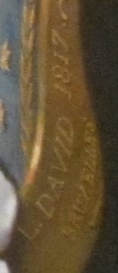 Inscription by David Inscription by David
Where? Gallery 201 of the Cleveland Museum of Art
When? 1817 Commissioned by? Giovanni Battista Sommariva, an Italian politician and art collector. What do you see? The beautiful nude Psyche sleeps on the bed after making love to Cupid. She has one arm over her head and the other arm lays over Cupid’s thigh. The couple lays on two large bedcovers that hang from the top of the painting. Cupid is awake and looks at the viewer with a smirky smile. He wears large white wings and has curly hair. However, something seems off about him. He looks like a teenager who is proud that he just made love to the most beautiful woman on Earth. He shows that pride with a somewhat annoying smile to the viewers. It seems that Cupid wants to sneak away as Psyche is not supposed to see who makes love to her every night. He tries to lift up the arm of Psyche such that he can leave (though he will still have to remove his wings from under Psyche’s body). The bow of Cupid stands against the bed below his right leg, and on the left side of the bed stands his quiver with arrows. Above the head of Psyche is a white butterfly, which is her symbol. Another butterfly is decorated on the middle of the bed frame in the middle of other gold decorations. In the background, we can look through a window at a landscape with mountains and a small temple. Jacques-Louis David has signed the painting on the footpiece on the right side of the bed. Backstory: This painting is also known under the name, Love and Psyche. Jacques-Louis David started this painting in 1813 when he still lived in Paris and finished it in 1817 when he lived in exile in Brussels. Before his exile, David was known for his paintings with political and social messages, but after his exile, he seemed to focus on less complicated subjects like the current painting. His sketchbooks from before his exile already contained many drawing of mythological subjects, so his exile was a good reason to convert some of those ideas into paintings. The story of Cupid and Psyche? This painting of Cupid and Psyche is based on a story that the Roman writer, Apuleius, wrote in his book Metamorphoses, chapters four, five, and six (you can download the book here for free). In short, Psyche was considered the most beautiful woman alive, and Cupid fell in love with her. The goddess Venus was jealous of her beauty. So, she sent Psyche on a very dangerous journey to the underworld to collect a flask with Proserpina’s beauty ointment. She succeeds with the help of Cupid. Venus instructed Psyche not to open the flask, but after she completes the journey, she could not resist and opened it to take some of the beauty. Instead of becoming more beautiful, the ointment makes her fall into a very deep sleep as Proserpina had filled the flask with sleep of the innermost darkness. Cupid forgives Psyche and revives her. Antonio Canova created a sculpture on the moment just after this revival. The sculpture, Psyche Revived by Cupid’s Kiss, is in the Louvre. After this, Cupid asks for the help of Zeus who makes Psyche immortal and Cupid and Psyche marry and stay together forever. The story of Psyche has inspired many artists over time, including Caravaggio, Raphael, Titian, and Vélazquez.
Symbolism: Most artworks on Cupid and Psyche focus on the love between both. They would show both of them with idealized bodies. However, that is not the case in this painting. At first glance, this painting seems to be about physical desire. Cupid is not depicted as a very handsome man, but as a teenager with a far from ideal face. He shares his pride about making love to such a beautiful woman by smirking at the viewer.
Looking a bit longer at the painting, it also presents a scene of the morning-after. They made love during the night, and in the morning, Cupid tries to sneak away from Psyche without saying goodbye. There has been quite some speculation about any deeper meanings behind this painting, especially because of the awkward depiction of Cupid, but no dominant one has emerged. Who is Jacques-Louis David? Jacques-Louis David was born in 1748 in Paris. He was one of the most popular painters during his life and one of the most famous Neoclassical painters. He was a supporter of the French Republic and Napoleon and even became the court painter of Napoleon. The Coronation of Napoleon in the Louvre is one of the magnificent paintings he created for Napoleon in 1807. After the fall of Napoleon in 1815, David was exiled from France. He wanted to spend the rest of his life in Rome, but the Pope did not approve this. Instead, he went to Brussels where he spent the rest of his life until his death in 1825. While in Brussels, he continued painting. One of the works he created there was The Farewell of Telemachus and Eucharis in the Getty Museum.
Where? Room 702 on the first floor of the Louvre
When? 1814 What do you see? A young courtesan rests atop some brightly colored blue and ochre fabrics from the east. She is surrounded by treasures from the orient—a bejeweled mirror just behind her, a red hookah at her feet, and beautiful patterned drapes that hang from above. She is nude, except for the exquisite oriental headdress atop her head and a few golden bracelets on her wrist. Her elongated right arm holds a beautiful peacock feather fan. She is modestly seductive, her eroticism simultaneously augmented and veiled by the mysticism of the east. Backstory: La Grande Odalisque was commissioned in 1813 by Napoleon’s sister, Caroline Murat, the Queen of Naples. The painting was admitted into the Salon of 1819 but received harsh criticism for a number of reasons. Firstly, this nude by Ingres was different from many reclining nudes of the past as those were painted in a mythological context, making them more appropriate for public display. The most famous work in this genre is the Venus of Urbino by Titian. Ingres, instead, veiled his nude in the mysticism of the east, a theme emphasized by many neoclassical painters like David and Delacroix. Nonetheless, the eroticism caused much discourse. Secondly, Ingres received criticism for his exaggerated and inaccurate rendition of human anatomy. Influenced by the 16th-century Mannerism art movement, Ingres elongated the body of his subject in numerous areas including her spine, right arm, and left leg.
Who is Ingres? Jean-Auguste-Dominique Ingres was a French painter born in born in 1780 in Montauban. His father was an artist and musician, and his mother was a wigmaker. His parents exposed him to the arts from an early age; he enrolled in art school, studying both sculpture and painting.
In 1797, Ingres began studying with Jacques-Louis David, and, in 1799, he was admitted to the Ecole des Beaux-Arts in Paris. Eventually, he won the Grand Prix de Rome, a prestigious art prize that allowed him to work in Rome for five years. While in Rome, he was commissioned by the Murat family in Naples to paint several portraits, though he never received payment for these paintings because of the fall of Napoleon’s empire. Stranded in Rome with no patronage, Ingres resorted to making portraits for English tourists. Soon, Ingres returned to France where he regained popularity with his The Vow of Louis XIII. However, he also continued to paint portraits including his portraits of Madame Moitessier, of which one version is in the National Gallery in London and another version in the National Gallery of Art in Washington, DC.
Fun fact: When looking at the woman, you can clearly see in her lower back that she has a few more vertebrae than normal. Critics of La Grande Odalisque often estimated that Ingres had added three extra vertebrae to his figure. However, a study conducted in 2004 showed that Ingres had actually added approximately five vertebrae to his model. This number was calculated by measuring female models and scaling them to the size of Ingres’s painting. Such an elongation suited the personal taste of Ingres who was influenced by Mannerism. He thought long and curved lines accentuated the sensuality and beauty of a figure.
 The wife of Socrates The wife of Socrates
Where? Room 621 of the Metropolitan Museum of Art
When? 1787 Commissioned by? The Trudaine de Montigny brothers What do you see? Socrates is sitting on his deathbed in his cell and is reaching for the glass of hemlock to take his own life. He is convicted to death by a jury in Athens for not believing in the Greek gods and for sharing this view with the young people in Athens. You can see the opened shackles laying on the floor. His disciples are gathered around him and cannot believe what is going to happen. The executioner from the state is holding the glass for Socrates while looking away and covering his eyes. Even in the moment just before his death, the illuminated Socrates is teaching to the people around him with his hand up in the air. Plato is sitting at the end of the bed with his back towards Socrates and his eyes closed. He seems in his thoughts, but his ear is prominently depicted to indicate that he is listening to Socrates. Plato has documented several dialogues of Socrates as Socrates himself did not leave any written documents. You can see the scroll and the pot with ink at Plato’s feet to indicate that he will document the final speech of Socrates. Sitting to the right of Socrates is Crito, a good friend of Socrates, who has his arm on his leg. Crito is sitting on a bench with an inscription of the symbol of the Athenian state. The wife of Socrates, Xanthippe, is in the left background in a red robe. She waves at us while walking away. Backstory: This painting is largely based on a dialogue of Plato, entitled Phaedo, in which he describes the death of Socrates. In this dialogue, Socrates discusses the life after death on the day before his execution. Socrates discusses various arguments on why the soul is immortal and that there is an afterlife for the soul. For his crimes, Socrates could choose between drinking the glass of the poisonous hemlock or being exiled. Given his ideas that his soul would go to an afterlife and staying true to his beliefs, he chose to drink the glass of hemlock. This painting can be interpreted in a political context. The Trudaine de Montigny brothers (who commissioned this work) were leaders of a movement that called for more open public discussion of political matters and a free market system. The motive behind this painting was to depict Socrates as an example of someone who was willing to die for his ideals. In 1787 reforms to the French political system were abandoned and there were many political prisoners. What is discussed in Phaedo? Phaedo is the fourth and final dialogue of Plato about the death of Socrates. In Phaedo, the story of Socrates is told about why he thinks that the soul is immortal and that there is life for the soul after a person dies. Phaedo also describes the death of Socrates. In short, the four arguments of Socrates are:
Who is Socrates? Socrates is one of the founders of Western philosophy. He was married to Xanthippe and got three sons. Socrates did not write any of his ideas on paper, but some contemporaries, such as Plato, have documented the ideas of Socrates such that his ideas have been saved for future generations. One of his most important contributions to the world is the so-called Socratic method. To solve a problem, Socrates would ask you a question. Based on your answer he would ask you another question, followed by another question, etc. He forced people to critically think about their answers by engaging them in the topic. If some of those answers led to contradicting answers, a certain hypothesis about the problem could be eliminated, and a better one could be formulated. It is basically a test of logic and will help a group of people to determine their views on a certain problem. The Socratic method has led to the currently-used scientific method that academicians use in which one starts with a hypothesis which can be rejected or accepted after research. Who is Jacques-Louis David? Jacques-Louis David (1748-1825) was born in Paris. He was a Neoclassical painter and together with Antonio Canova he is one of the main representatives of this art style. In his twenties and thirties, he spent quite some years in Rome where he got inspired by the Renaissance paintings and especially by the work of Raphael. David supported the French Revolution and Napoleon, and one of his famous paintings is The Coronation of Napoleon which is in the Louvre. After the fall of Napoleon, he moved to Brussels where he stayed until his death. He loved to make historical paintings while staying true to his Neoclassical style. In this painting, you can, for example, see how the body of Socrates resembles an ancient Greek sculpture. One of his most famous students is Eugene Delacroix.
Fun fact: There are several aspects of this painting that Jacques-Louis David changed compared to the historical accounts of the death of Socrates.
Where? Gallery 299 of the Philadelphia Museum of Art
When? 1812 Commissioned by? Count Camille de Tournon, the son of the Countess de Tournon What do you see? A portrait of the about 60-year old Countess of Tournon sitting in an armchair against a brownish background. This painting often leads to some discomfort among the viewers. Unlike most other portraits by Ingres, the countess is not a young and beautiful woman. Most people agree that she is not very attractive. Ingres has depicted her quite realistically. For example, her eyes are a bit swollen, she has a very large nose, she has a faint mustache, and she has a bit of a double chin. She also has a wart in between her eyes. However, Ingres has probably also idealized some other parts as the Countess does not look like 60 years old. For example, look at her unwrinkled face and her smooth arms. Instead of her beauty, the painter has focused on depicting her alertness, wisdom, and confidence. She has a small, but confident, smile and looks directly at the viewer. She is dressed in expensive and fashionable clothes. She wears a white transparent veil with flower decorations in her hair, a lace ruff around her neck with a transparent undergarment of lace below it, and a green velvet dress. Over the armchair and on her lap lays a cashmere shawl with flower patterns. Backstory: This painting is also referred to in French as Comtesse de Tournon. Ingres created this painting while he was staying in Rome, which was at that time part of the French empire of Napoleon. The Countess of Tournon was born as Geneviève de Seytres Caumont and is the mother of Philippe-Marcellin Camille de Tournon-Simiane. Between 1809 and 1814, Camille de Tournon was the French Prefect of Rome during Napoleon’s reign. During a cleaning of the painting in 1995 by the Philadelphia Museum of Art, the wart was discovered in between the eyes of the Countess. As the painting stayed for a long time in possession of the Tournon family, it is likely that a family member has applied some extra paint to this work after it was finished to conceal the wart. Who is Ingres? Jean-Auguste-Dominique Ingres was born in 1780 in Montauban in the South of France and died in 1864 in Paris. His father was an artist himself, and from an early age, he provided Ingres with very good art education. In 1797, he became a pupil of Jacques-Louis David, who trained him as a Neoclassical painter. During his life, Ingres lived in Paris, Rome, and Florence. He wanted to become a history painter as that was considered to be the highest level of painting. However, in the early part of his career, he received relatively few commissions for history paintings. Instead, to support his family he created portrait paintings on commission. Portraits by Ingres: Ingres considered himself to be a history painter, but we remember him nowadays mainly because of his beautiful portraits. He has painted a large number of portraits during his career. For example, the two paintings of Madame Moitessier are well-known. The first version hangs in the National Gallery of Art in Washington, DC, and the second version in the National Gallery in London. Two other examples of excellent portraits are Princesse de Broglie in the Metropolitan Museum of Art and the Portrait of Monsieur Bertin in the Louvre.
Fun fact: When a portrait of someone was commissioned, painters usually did their best to depict the person in a beautiful and flattering way. This is also what Ingres usually did as is evidenced by the portraits shown above. However, the Countess of Tournon is not primarily depicted as a beautiful woman.
The realism that Ingres included in this painting is comparable with some of the portraits of the 18th and 19th century Spanish artist Francisco Goya. A good example is the face of King Ferdinand VII of Spain in a portrait that Goya painted of him. Another example is the faces of Charles IV and his family in a painting by Goya in the Prado Museum. Interested in a copy for yourself? Poster or canvas
Where? Room 45 of the National Gallery
When? 1856 Commissioned by? Paul Sigisbert Moitessier, the husband of Madame Moitessier. What do you see? Madame Moitessier is seated on a decorated sofa, also referred to as a canapé. She is wearing a large colorful silk dress with flower patterns. She probably wears a farthingale under her dress, which allows the bottom part of the dress to keep its circular shape. She is looking a bit sensual. For example, look at the blush on her cheeks. Her right hand is casually placed against the side of her head as was often done with Greek statues and she is holding a folding fan in her left hand. You can see the opulence in this painting. Madame Moitessier is wearing expensive bracelets, a ring, a necklace, decorated with various rubies. On the left, you can see a richly decorated screen fan and an expensive vase. Ingres believed that to paint a portrait you have to study the person from all angles and understand all her sides. This is reflected in the mirror that he included in the painting, which shows another side of Madame Moitessier (although it seems unlikely that this mirror is in the correct angle). This side shows her more naturally, with less jewelry. You can also see a candle tree in the mirror. Backstory: Ingres started with this painting around 1847, but only completed it in 1856 when he was 76 years old. He first got the invitation to paint a portrait of Madame Moitessier in 1844, but he refused that assignment as he was focused on mythological paintings. However, when he later met her, he changed his mind as he was very impressed by her looks which made him remember of Juno (the so-called Junoesque look, which means that she looked beautiful and dignified at the same time, just like the goddess Juno). Who is Madame Moitessier? Marie-Clotilde-Ines Moitessier (1821–1897) was the wife of Paul Sigisbert Moitessier, a wealthy banker and merchant. She was also known by her maiden name De Foucauld, which you can see by the inscription at the top right of this painting. Madame Moitessier was also the aunt of Charles de Foucauld, a famous French priest who was beatified by the Pope in 2005. Another portrait of Madame Moitessier: In 1851, Ingres painted another portrait of Madame Moitessier that is currently on display in the National Gallery of Art in Washington, D.C. He painted this second portrait while he had not finished the first one yet.
Who is Ingres? Jean-Auguste-Dominique Ingres (1780-1867) was born in Montauban, in the southwest of France. He was one of the primary Neoclassical painters. He considered himself to be a history painter but also painted quite some portraits during his career. Especially early in his career, he painted portraits to sustain himself. Interestingly, nowadays he is famous for the portraits that he painted.
His perfectionism may cause part of this fame. He found it very difficult to complete portraits, and he often got very frustrated and overwhelmed by these portrait assignments. A large part of his frustration came from the fact that the richer women that wanted a portrait could not hold their pose for an extended period of time. They tended to stand up and look at the painting and change the position of their dress and jewelry while he was painting them. In the end, however, he delivered stunning portraits. Fun fact: Ingres started some initial drawings for this painting in 1844. The idea was the Madame Moitessier was sitting with her daughter Catherine at her knee. Ingres, however, became severely frustrated during this process, partly because he found the daughter of Madame Moitessier very difficult to handle. After a few years, he decided that he should eliminate the daughter from this project, though that did not speed up the process. In 1849, the wife of Ingres died and he decided to stop his work on this painting. Only in 1852, after he remarried, he continued his work on this painting to ultimately finish it in 1856. Interested in a copy for yourself? Poster
Where? Gallery 56 of the National Gallery of Art
When? 1812 Commissioned by? Alexander Douglas, the Duke of Hamilton, Scotland What do you see? Napoleon poses in his study in the Tuileries Palace. He has worked all night on the Code Napoléon, which is the civil code full of laws for his empire. His work is illustrated by the quill pen on the left of the desk, the papers laying on the right side of the desk, and the scroll with the letters ‘COD,’ which is the Code Napoléon. He gets up from his work to carry his sword and inspect his troops. Napoleon wears the uniform of the foot grenadiers of the Imperial Guard, a group of elite soldiers in the French army. His uniform consists of the colors of the French flag: blue, white, and red. His uniform is decorated with several military awards (including the legion of honour on the left, the highest French military award), gold buttons, and gold epaulets. He has his right hand in his vest, which is a typical pose for Napoleon, and in his left hand, he holds a so-called snuffbox filled with tobacco. Jacques-Louis David included quite some details in this painting that help to tell a story about Napoleon.
Backstory: In 1811, Alexander Hamilton (1767-1852), the Marquis of Hamilton, contacted Jacques-Louis David to paint a portrait of Napoleon. The Duke admired Napoleon for his power and asked David to “transfer onto the canvas the features of the Great Man, and represent him in one of the historic moments that have made him immortal.” For the rest, David was free to decide on the content of the painting, and he could even decide himself on the price that the Duke would have to pay for it. David happily accepted the commission as it was a recognition of his fame outside France, he did not have any major commissions from the French government, and he could earn a lot of money with it. The painting is since 1961 in the National Gallery of Art.
Symbolism: Jacques-Louis David wanted to portray Napoleon as a correct and truthful man. He also wanted to indicate that Napoleon worked very hard for his empire. He purposely included a clock with the time of 4.13am and a candle that was almost finished to indicate that Napoleon was still working deep into the night.
To further emphasize the hard work of Napoleon, David paints him with unkempt hair, wrinkled stockings wrinkled, and the cuffs of his uniform are not all buttoned. Also, the snuffbox in his right hand shows that he used the tobacco to stay awake. The military decorations and the sword on the chair indicate his success as a military leader. The golden bees on the chair on the left symbolize the diligence of Napoleon. Who is Napoleon? Napoléon Bonaparte (1769-1825) was a military political leader in France. He was the leader of the French Revolution in 1789 and became the Emperor of France in 1804. For the next decade, he was the most important statesman in Europe as the French Empire spanned across a large part of Europe, including countries like Italy, Belgium, and The Netherlands. Who is David? Jacques-Louis David (1748-1825) was born in Paris and died in Brussels, Belgium. He is considered the most important Neoclassical painter. David was an admirer of Napoleon and Napoleon was also a big fan of the work of David. In 1804, David became the official court painter of the French empire. He painted multiple works of Napoleon, including the famous The Coronation of Napoleon in the Louvre. Due to his focus on neoclassicism, he also painted a large number of paintings with classical themes, such as The Death of Socrates (1787) in the Metropolitan Museum of Art and The Farewell of Telemachus and Eucharis (1818) in the Getty Museum.
What is the Tuileries Palace? A palace in Paris that was used by many French monarchs until it burned down in 1871. It was built in 1564 and was an enormous palace in the middle of Paris, next to the Louvre.
Fun fact: Napoleon liked art. For example, the Mona Lisa by Leonardo da Vinci hung in his bedroom. He ordered his troops to bring a lot of famous artworks from throughout Europe to France, including the Apollo Belvedere and The Entombment of Christ by Caravaggio in the Vatican Museums, and The Wedding at Cana by Paolo Veronese in the Louvre. He was also a commissioner and collector of contemporary art, though often to promote himself or his empire. Some of the paintings by David, such as the Coronation of Napoleon, are a good example of this self-promotion. Interested in a copy for yourself? Poster. |
Categories
All
|
- Home
- Blog
-
Museums
- Alte Pinakothek
- Art Institute of Chicago
- Baltimore Museum of Art
- Barber Institute of Fine Arts
- Bargello
- Barnes Foundation
- British Museum
- Church of Sant’Anastasia
- Cleveland Museum of Art
- Courtauld Institute of Art
- Detroit Institute of Arts
- Frans Hals Museum
- Galleria Borghese
- Gallerie dell'Accademia
- Getty Museum
- Guggenheim
- Hermitage Museum
- Kunsthistorisches Museum
- Kunstmuseum Basel
- Legion of Honor Museum
- Louvre
- Mauritshuis
- Metropolitan Museum of Art
- Musee d’Orsay
- Museum of Fine Arts in Boston
- Museum of Modern Art
- National Gallery in London
- National Gallery of Art
- National Museum in Poznań
- Norton Simon Museum
- Ny Carlsberg Glyptotek
- Palace of Versailles
- Palazzo Pitti
- Palazzo Vecchio
- Petit Palais
- Philadelphia Museum of Art
- Prado
- Pushkin Museum
- Ravenna Art Museum
- Rijksmuseum
- San Diego Museum of Art
- Santa Maria delle Grazie
- St. Peter's Basilica
- Städel Museum
- Statens Museum for Kunst
- Tate Britain
- Tate Modern
- Timken Museum of Art
- Uffizi
- Vatican Museums
- Wallace Collection
-
Artists
- Altdorfer
- Anguissola
- Berlin Painter
- Bosch
- Botticelli
- Boucher
- Bronzino
- Bruegel the Elder
- Brunelleschi
- Cabanel
- Caillebotte
- Canova
- Caravaggio
- Carpeaux
- Cezanne
- Cimabue
- David
- Degas
- Delacroix
- De Maria
- Donatello
- El Greco
- Fontana
- Fra Angelico
- Fragonard
- Gauguin
- Gentileschi
- Gericault
- Gonzalez-Torres
- Goya
- Hals
- Hogarth
- Hokusai
- Ingres
- Leonardo da Vinci
- Lippi, Filippo
- Longhi, Barbara
- Lorrain
- Makovsky
- Manet
- Massys
- Matisse
- Merian
- Michelangelo
- Mochi
- Modigliani
- Monet
- Panini
- Parmigianino
- Perugino
- Picasso
- Pisanello
- Raphael
- Rembrandt
- Renoir
- Reynolds
- Rivera
- Rodin
- Rubens
- Scultori
- Seurat
- Steen
- Tintoretto
- Titian
- Toulouse-Lautrec
- Turner
- Uccello
- Van der Weyden
- Van Dyck
- Van Eyck
- Van Gogh
- Van Hemessen
- Vasari
- Velazquez
- Vermeer
- Veronese
- Vigée Le Brun
-
Locations
- Books
- About Us

